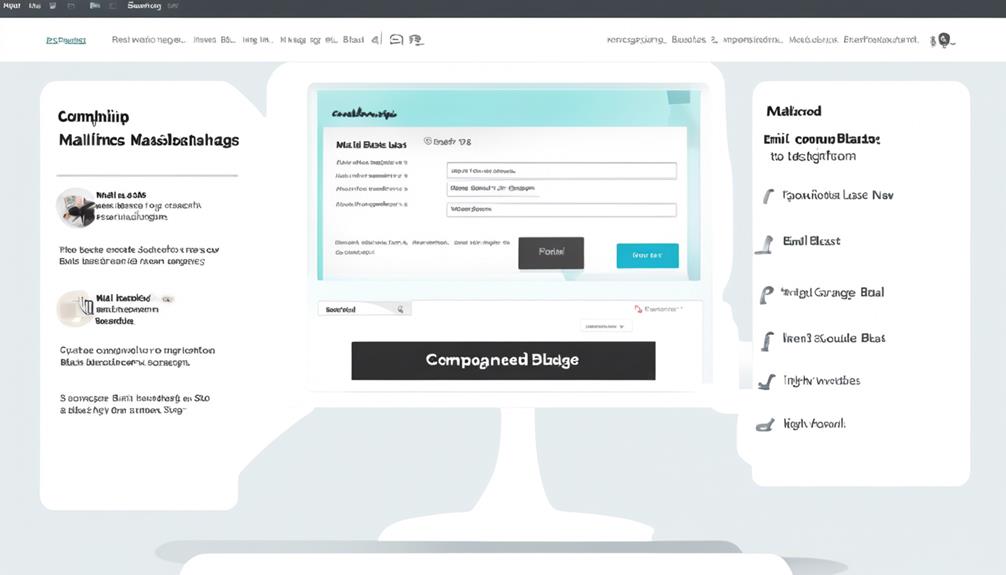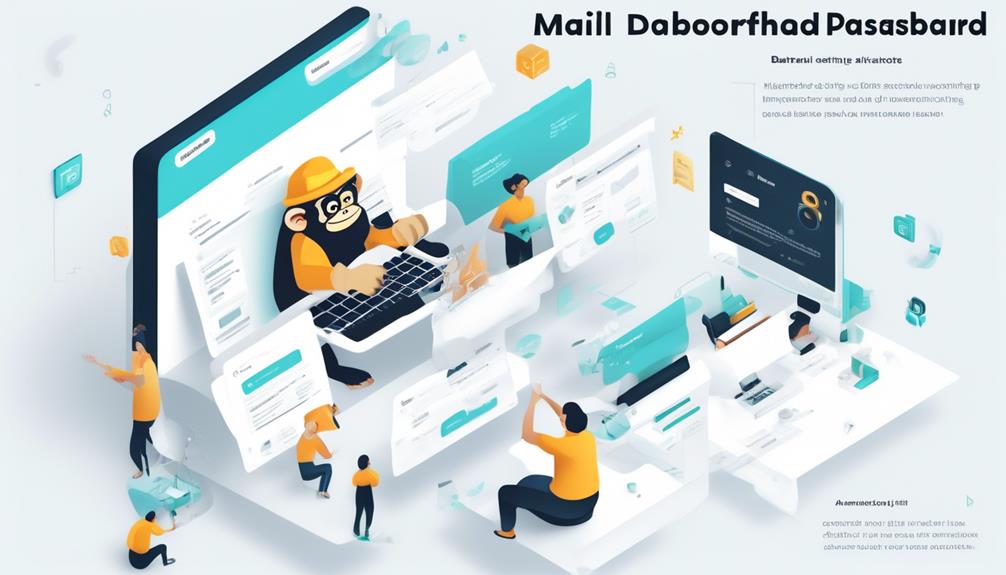How to Write Email
How to Send an Email Blast with Mailchimp in 10 Easy Steps
Open the door to simplified email marketing on Mailchimp with expert tips and strategies – discover the secrets to success.

Have you ever thought that using Mailchimp to send out a mass email might be easier than it seems? Let’s go through the detailed steps of how this can be done together.
From fine-tuning your audience segmentation to crafting engaging content and analyzing performance metrics, there's a methodical approach to master.
Join us as we dissect each step and uncover the key strategies for successful email marketing campaigns.
Key Takeaways
- Create targeted campaigns and ensure error-free content and functioning links.
- Utilize pre-built journeys for efficient automation and track engagement metrics.
- Customize email design with drag-and-drop editor and personalize with merge tags.
- Monitor campaign performance, track metrics, and make data-driven decisions for improvement.
Overview of Email Blast Feature

Let's dive into the efficiency of Mailchimp's Email Blast feature for enhancing your email marketing campaigns.
When using Mailchimp to send an email blast, it's essential to create and send your campaign to the right audience segments. Before hitting send, ensure your content is error-free, links work correctly, and preview and test your email for optimal performance. Mailchimp provides valuable help articles to guide you through this process.
After sending your email blast, don't forget to monitor deliveries, track engagement metrics, and assess revenue using email reports. By paying attention to unsubscribes and bounces, you can promptly address any arising issues to maintain a healthy email list. Utilize Mailchimp's pre-built journeys to automate various types of email campaigns efficiently.
To enhance your sending strategy, take advantage of features like Send Time Optimization, Timewarp, and Batch Delivery available with Mailchimp's Standard and Premium plans. These tools help analyze subscriber engagement, deliver emails at the best time, and manage server strain effectively. Schedule your email blasts strategically and watch your click rates soar.
Setting Up Your Email List

Setting up your email list involves carefully reviewing your audience and ensuring proper permission for sending communications to them. Start by navigating to your Mailchimp account and accessing the Audience tab. Here, you can manage your email addresses, add recipients, and click save to confirm your list.
Before crafting your email content, it's crucial to design your email in the Content section. Customize it to align with your Mailchimp campaigns and account details. Utilize the Preview mode to see how your email will appear to recipients. Once satisfied, hit the Send button to dispatch your message. Remember to always send a test email first to ensure everything looks and functions as intended.
Designing Your Email Campaign
After carefully setting up your email list in Mailchimp, the next step is to meticulously design your email campaign for maximum impact and engagement.
To start designing your email campaign, log in to your Mailchimp account, select Campaigns, and then click Create Campaign.
Choose the Regular, automated email, or Campaign Builder option, depending on your needs.
In the Campaign Builder, you can use the drag-and-drop email editor to create visually appealing content.
Personalize your emails by using merge tags, which allow you to add subscriber information dynamically.
Before you send the email, click Edit to review your content, check for errors, and ensure all links work correctly.
Utilize the Preview and testing tools to see how your email will display across different devices and email clients.
Once you're satisfied with the design and content, click Add recipients and schedule your campaign for optimal delivery time.
Be sure to monitor engagement metrics after sending to evaluate the success of your email campaign.
Scheduling and Sending Your Email Blast

When determining the ideal timing to schedule your email blast, consider the preferences and habits of your target audience for optimal engagement. Here are some key tips to ensure your email blast is sent out successfully:
- Choose the Right Time: Select a time when your audience is most likely to check their emails, such as during regular working hours or evenings.
- Test Before Sending: Make sure to test your email blast by sending it to yourself or a small group first to check for any formatting issues or errors.
- Avoid Overwhelming Subscribers: Be mindful of how frequently you send out email blasts to prevent overwhelming your subscribers with too many messages.
- Use MailChimp Features: Take advantage of MailChimp's scheduling features like Send Time Optimization and Batch Delivery to ensure your emails are sent at the best times for maximum impact.
Monitoring Campaign Performance
To optimize the effectiveness of your email blasts, it's crucial to closely monitor the performance of your campaigns, from delivery rates to subscriber engagement metrics. By tracking key metrics like open rates, click rates, and revenue generated, you gain valuable insights into the effectiveness of your email marketing efforts. Mailchimp provides detailed reports that allow you to assess the success of your campaigns and make data-driven decisions for future strategies.
Utilize tools like Send Time Optimization, Timewarp, and Batch Delivery to enhance your email performance based on subscriber behavior and preferences. These features, available with Standard and Premium plans, help you maximize engagement and ensure your emails reach recipients at the most opportune times.
Monitoring unsubscribes, bounces, and audience demographics can help you fine-tune your targeting and content to better resonate with your audience. By regularly analyzing campaign performance, you can continuously improve your email marketing strategy and achieve better results.
Frequently Asked Questions
Can I Use Mailchimp to Send Bulk Emails?
Yes, we can use Mailchimp to send bulk emails. It's important to review our audience and set up segments accurately. Proofreading content, checking links, and testing are crucial. Monitoring delivery and engagement metrics helps track effectiveness.
Mailchimp's pre-built journeys and automation features create personalized campaigns. Features like Send Time Optimization and Batch Delivery optimize bulk email sending. To access these, we may need a Standard or Premium plan.
Scheduling campaigns is easy, and we can pause and reschedule when needed.
How Do I Send an Email to Multiple Recipients in Mailchimp?
When sending an email to multiple recipients in Mailchimp, we ensure proper audience segmentation and permission. We proofread content, check for broken links, and use testing tools for correct display. Monitoring deliveries, engagement, revenue, unsubscribes, and bounces is crucial.
Utilize Mailchimp's features like preview, testing, and scheduling. Take advantage of Send Time Optimization, Timewarp, and Batch Delivery. Access support for technical help and adjust time zone settings for optimal delivery times.
How Many Emails Can Mailchimp Send at Once?
We can send a substantial number of emails at once through Mailchimp. The amount of emails that can be sent in one go varies depending on the type of plan you have.
Mailchimp's infrastructure is crafted to manage high-volume sending efficiently, allowing us to reach our audience effectively.
Remember to segment your recipients and review your email setup for optimal delivery and engagement rates.
Monitoring performance and utilizing features like Send Time Optimization are key to success.
Can You Send a Mailchimp Campaign Multiple Times?
Yes, we can send a Mailchimp campaign multiple times. By updating triggers for each email, setting schedules, filtering by segment, adding tags, designing automated emails, analyzing campaign data, and integrating with other apps, we can efficiently send multiple campaigns.
Utilizing features like Send Time Optimization, Timewarp, and Batch Delivery, available in Standard and Premium plans, ensures successful email campaigns. Adjusting plan types on the plans page grants access to these valuable features.
Conclusion
In conclusion, sending an email blast on Mailchimp is a powerful way to reach your audience effectively.
Did you know that email marketing has an average ROI of $42 for every $1 spent?
Imagine the possibilities of reaching your customers and driving revenue with just a click of a button.
Don't miss out on this valuable tool to connect with your audience and boost your business.
Start sending those email blasts today!
Natali – Editor in Chief (Strategy and Mastery, AI Expert) Natali, our Editor in Chief, is the driving force behind our content’s strategic direction. With a keen eye for detail and a deep understanding of market trends, Natali ensures that our content is top-notch and strategically aligned with our client’s goals. Her expertise in AI helps to seamlessly integrate advanced technology into our marketing strategies, pushing the boundaries of conventional marketing.
How to Write Email
Make Your Message Stand Out with a P.S. in Email

Welcome to our guide on how to effectively utilize the “P.S.” in your emails to grab attention. In today’s digital age, it is essential to master the art of creating impactful emails to effectively convey your message, engage your audience, and achieve your goals. This article explores the significance and function of “P.S.” in email marketing. We will showcase examples of its usage, discuss the best practices for incorporating it, and offer tips on crafting a compelling “P.S.” to elevate your email communications.
- Using “P.S.” in emails can enhance your message and capture recipients’ attention.
- “P.S.” can be used as a powerful tool in email marketing campaigns to drive engagement and conversions.
- Adding a personal touch and using “P.S.” strategically can make your emails more effective.
- Understanding when and how to use “P.S.” properly is important to maintain professionalism and avoid miscommunication.
- An effective “P.S.” can optimize email engagement and help achieve your communication objectives.
Why and How to Use “P.S.” in Your Emails
When it comes to email communication, adding a “P.S.” (postscript) can be a powerful tool to capture your recipient’s attention and make your message stand out. In this section, we will explore the meaning of “P.S.” and its significance in email marketing. We will also provide examples of how to effectively use “P.S.” to enhance your emails, as well as discuss when it is appropriate to include a “P.S.” in your emails or letters. Additionally, we will delve into how using a “P.S.” can be valuable for adding punctuation and clarity to your messages.
Understanding the Meaning of “P.S.”
The term “P.S.” originates from the Latin phrase “post scriptum” meaning “written after.” In email communication, a “P.S.” is an additional message or thought that is added after the main body of the email. It is often used to highlight important information, provide additional context, or create a sense of urgency.
Using “P.S.” in Email Marketing
In email marketing, a well-placed “P.S.” can help drive engagement and increase the effectiveness of your campaigns. By strategically using a “P.S.” at the end of your marketing emails, you can reinforce your key message, highlight a special offer or call-to-action, and create a sense of personal connection with your audience.
Examples of Using “P.S.” to Enhance Your Emails
Here are a few examples of how you can use “P.S.” to enhance your emails:
- Add a personal touch: In your follow-up emails, include a “P.S.” to mention something specific about the recipient, showing that you value their individuality.
- Create urgency: Use a “P.S.” to emphasize a limited-time offer or a deadline for taking advantage of a promotion.
- Include a call-to-action: Use a “P.S.” to urge your recipients to take a specific action, such as clicking on a link or replying to the email.
- Reinforce your main message: Summarize the key point of your email in the “P.S.” to ensure it sticks with your recipient.
When to Use “P.S.” in Your Emails or Letters
Knowing when to use a “P.S.” in your emails or letters is essential for maximizing its impact. Here are a few instances where including a “P.S.” can be effective:
- Adding an afterthought: If you have an additional idea or information that is relevant to your message but not crucial to the main body of your email, a “P.S.” is the perfect place to include it.
- Highlighting important details: Use a “P.S.” to draw attention to key information that you want your recipient to remember, such as a meeting time or an important attachment.
- Enhancing readability: If you have a lengthy email, you can use a “P.S.” to break up the text and provide a concise summary or final thought.
Using “P.S.” for Added Punctuation and Clarity
In addition to its traditional purpose, a “P.S.” can also be used for added punctuation and clarity in your messages. By using a “P.S.” to address any remaining thoughts or questions, you ensure that the rest of the email or message flows smoothly and with a clear structure.
Next, we will delve into best practices for using “P.S.” in email communication to ensure you make the most out of this powerful tool.
Best Practices for Using “P.S.” in Email Communication
When it comes to email communication, adding a personal touch can go a long way in making your message stand out. One effective way to achieve this is by utilizing the “P.S.” (postscript) technique. By strategically placing a “P.S.” at the end of your email, you can capture your recipient’s attention and convey important information that might have been missed in the body of the email.
Writing “P.S.” in the Body of the Email
When using the “P.S.” technique, it is crucial to ensure that the content in the body of the email is concise and to the point. The purpose of the “P.S.” is to provide additional information or emphasize a key point, so make sure the body of the email is clear and complete without relying solely on the “P.S.” for important details.

Adding a Personal Touch with “P.S.”
One of the advantages of using “P.S.” in email communication is the opportunity to add a personal touch. You can use the “P.S.” to express gratitude, share a personal anecdote, or address the recipient by name. This personal touch can help create a stronger connection and make your email feel more sincere and authentic.
Considerations for Using “P.S.” in Email Marketing Campaigns
If you are incorporating “P.S.” in your email marketing campaigns, it is essential to ensure that the placement of the “P.S.” is strategic and relevant. A well-placed “P.S.” can draw attention to a call-to-action, highlight a limited-time offer, or provide additional information that encourages engagement and click-through rates.
Ensuring Proper Use of “P.S.” in Your Email or Letter
To ensure the proper use of “P.S.” in your email or letter, it is important to keep the following guidelines in mind:
- Keep the “P.S.” short and concise to maintain its impact.
- Use the “P.S.” to convey important information or emphasize a key point.
- Avoid using “P.S.” multiple times in a single email or letter, as it may diminish its effectiveness.
- Proofread your email or letter to ensure that the “P.S.” is grammatically correct and supports your overall message.
Utilizing “P.S.” as an Additional Means of Communication
Besides its traditional use in email communication and letter writing, “P.S.” can also be utilized as an additional means of communication in various contexts. For example, you can include a “P.S.” in a personal email to express your appreciation, ask a follow-up question, or make an extra point. The versatility of “P.S.” makes it a valuable tool for effective communication in various scenarios.
Tips for Writing an Effective “P.S.”
Now that we understand the importance of using “P.S.” in our email communication, let’s explore some tips for writing an effective “P.S.” that captures attention and engages recipients. By following these guidelines, you can make the most of this powerful tool and optimize email engagement.
How to Make the Most of “P.S.” in Your Email’s Main Body
When crafting your email, strategically place the “P.S.” in the main body to create a lasting impression. Use it to summarize your key message or highlight a call to action. By placing the “P.S.” at the end of your email, it ensures that even skimmers and readers with short attention spans will notice and remember your message.
Adding an Afterthought with “P.S.”
The “P.S.” is not just reserved for important information; it can also be used to add a personal touch and create a sense of familiarity with your recipients. Use the “P.S.” to share a relevant anecdote, ask about their well-being, or mention something specific to your relationship. This way, you not only capture attention but also strengthen the connection with your audience.
Understanding the Importance of “P.P.S.” in Email Communication
While “P.S.” is widely known, “P.P.S.” is a lesser-known gem that can further enhance your email communication. Use “P.P.S.” to include a secondary message, an additional call to action, or an update related to your main email. The unexpected nature of “P.P.S.” can pique curiosity and encourage recipients to thoroughly read your message.
Using “P.S.” in Personal Email Messages
“P.S.” is not limited to business or professional emails. It can also be a valuable addition to personal email messages. Whether you’re writing to a friend, family member, or significant other, the “P.S.” can inject personality, humor, or a heartfelt sentiment. Use it to share an inside joke, express your love, or even include a fun fact.
Optimizing Email Engagement with “P.S.”
To ensure maximum impact, keep your “P.S.” concise and focused. Use attention-grabbing language, such as introducing a limited-time offer or a compelling benefit. Additionally, consider using formatting techniques such as bold or italics to make your “P.S.” visually stand out. By optimizing your “P.S.”, you can captivate your recipients and increase email engagement.
Remember, the “P.S.” is a powerful tool that can improve the effectiveness of your email communication. Use it strategically, test different approaches, and pay attention to the responses you receive. With the right implementation, your “P.S.” can make a lasting impression and drive desired actions from your recipients.

Conclusion
As we conclude our exploration of using “P.S.” in email communication, it becomes evident that this simple yet powerful technique can significantly enhance your messages. By incorporating a well-crafted “P.S.” at the end of your emails, you can capture the attention of your recipients, make your message stand out, and increase engagement.
The key takeaway from this article is that “P.S.” serves multiple purposes in email communication. It can be used as an effective marketing tool by adding a personal touch or emphasizing a call-to-action. Additionally, it can be utilized to provide further information or clarify the main body of the email, making it an essential communication tool.
Remember, strategic use of “P.S.” can make a lasting impression on your recipients and differentiate your emails from the rest. Whether you are sending a professional email, a marketing campaign, or a personal message, incorporating a well-crafted “P.S.” can help you achieve your communication goals.
So, don’t underestimate the power of the postscript. Start incorporating “P.S.” in your emails today, and witness the positive impact it has on your email communication. By effectively using “P.S.”, you can ensure that your messages are noticed, remembered, and acted upon.
To write “P.S.” in an email, simply add it at the end of your message after the main body of the email. It can be used to add an afterthought, additional information, or a call to action. The “P.S.” should be short and to the point, grabbing the reader’s attention and reiterating a specific point. Using “P.S.” in your emails can be an effective way to add a personal touch and make your message stand out. It can also serve as a last chance to make a strong impression or drive a specific action. “P.S.” can be used in both personal and professional settings to enhance your email communication.
Yes, “P.S.” can be a valuable tool in email marketing campaigns. It can help create a sense of urgency, highlight additional benefits of a product or service, or encourage recipients to take action. Make sure to use “P.S.” strategically and in a way that aligns with your overall marketing message.
“P.S.” can be used in various situations, such as adding important information that was initially forgotten, emphasizing a key point, or adding a personal touch. It is generally placed at the end of the email or letter, but it can also be used within the body of the message if it is relevant. Use “P.S.” when you want to capture the reader’s attention and leave a lasting impression.
To make the most of “P.S.” in the main body of your email, use it sparingly and strategically. It can be used to reinforce a specific point, provide additional information or resources, or highlight a call to action. Keep the “P.S.” short and concise, ensuring that it adds value to the overall message.
FAQ
How do I write “P.S.” in an email to make my message stand out?
Why should I use “P.S.” in my emails?
Can I use “P.S.” in email marketing campaigns?
When is it appropriate to use “P.S.” in my emails or letters?
How can I make the most of “P.S.” in my email’s main body?
Erik – Email, SEO, AI Expert Writer Erik is the strategist, the thinker, and the visionary. His role at Influenctor is pivotal in integrating SEO with AI-driven content strategies. With an extensive background in email marketing and a profound understanding of search engine algorithms, Erik develops innovative strategies that elevate our client’s online presence. His work ensures that our content is seen, felt, and remembered.
How to Write Email
How to Write a Professional PTO Request Email
Planning to request time off but not sure how to approach it? Learn the art of crafting a PTO request email with professionalism and gratitude.

We’ve all had those moments when we need to take a break and recharge our batteries. It’s like trying to drive a car on empty – eventually, you just have to refuel. If you want to keep going strong and avoid burnout, taking regular breaks is essential. So, don’t forget to pause and recharge when needed!
But how do you go about asking for that necessary time off without causing a disruption or feeling like you're stepping on toes? Well, it's all about finding the right balance of professionalism and gratitude.
As we navigate through the nuances of requesting PTO, it's crucial to strike the right tone and approach. So, let's explore the art of crafting a PTO request email that not only conveys our appreciation for the opportunity but also ensures a smooth process for everyone involved.
Key Takeaways
- PTO is a valuable benefit that contributes to employee happiness and prevents burnout.
- Understanding the formal request process for PTO is essential, including advance notice and completion of a leave request form.
- Crafting a persuasive PTO request email involves clearly stating the dates, providing a valid reason, expressing willingness to be available for emergencies, using a professional tone, and offering to make coverage arrangements.
- Tips for successful time off requests include planning ahead, stating dates and reasons clearly, following up with managers, and communicating with the team before and after the time off.
Understanding PTO and Its Significance
Understanding the significance of taking paid time off (PTO) is essential for maintaining a healthy work-life balance and promoting overall employee well-being and satisfaction.
PTO, as defined by our company's employee handbook, is a valuable benefit that allows us to take time off while still receiving pay. This benefit is a clear demonstration of our company culture's understanding and support for the well-being of its employees. Taking regular breaks through PTO not only contributes to employee happiness but also prevents burnout and turnover, making it significant for both employees and employers.
In order to request PTO, it's essential to understand the formal request process, which often requires advance notice and completion of a leave request form. Moreover, understanding the significance of PTO request emails can't be overstated. These emails not only demonstrate professionalism and respect for company policies but also provide a written record for clarity in communication and obtaining approval for time off.
Therefore, understanding PTO and its significance is crucial for both personal well-being and effective communication within the workplace.
Crafting a Persuasive Request Email

Transitioning from the importance of PTO to the practical application, crafting a persuasive request email is essential for effectively communicating the need for time off in a professional manner.
When writing a PTO request email, it's crucial to clearly state the dates you're requesting, providing a specific timeframe for your absence.
Additionally, it's important to articulate a valid reason for your time off, such as a family event or personal trip, to give context and importance to your request.
Furthermore, it's essential to express your willingness to be available for urgent matters during your time off, demonstrating your commitment and responsibility.
Using a professional tone and format is crucial, especially in formal environments, as it conveys respect and professionalism.
You should also make sure to offer to make arrangements for coverage while you're away, showing consideration for the impact of your absence.
Lastly, it's important to let your manager know that you'll be available via email or phone for any urgent matters that may arise during your absence.
Craft your email requesting PTO with these elements to effectively ask for vacation time while maintaining professionalism.
Examples of Effective PTO Request Emails
We will now examine several examples of effective PTO request emails that adhere to professional standards and effectively convey the need for time off.
When writing a vacation request email, it's essential to be clear about the dates you're requesting for time off. For instance, 'I would like to request vacation time from September 15th to September 25th.'
Use a professional and respectful tone, especially in formal work environments, to request vacation time. Furthermore, in your vacation request email, provide a valid reason for your time off, such as a family event or a personal trip, to ensure your request is well-received.
It's important to make it easy for your manager or HR department to understand your request and make arrangements for coverage while you're away. You can offer to help in finding coverage or training a colleague to ensure a smooth workflow during your absence.
Additionally, maintain open communication and express your willingness to be available for emergencies during your time off. By following these examples of effective PTO request emails, you can effectively convey your need for time off while demonstrating your commitment to your responsibilities.
Tips for Successful Time Off Requests

After examining examples of effective PTO request emails, it's essential to understand the key tips for successfully requesting time off from work.
- Plan Ahead: Request time off well in advance, especially for longer vacations or during busy periods. This allows your manager and team to plan for your absence and ensures a smoother transition.
- Be Clear and Concise: When writing the PTO request email, clearly state the dates you're requesting for time off and the reason for your absence. Use a professional and polite tone in your email.
- Offer Coverage: If possible, offer to make arrangements for coverage during your absence. This shows consideration for your team and helps ensure that work continues smoothly in your absence.
- Stay Available: Express your willingness to be available for any emergencies that may arise during your time off. Providing a contact number or email address where you can be reached shows responsibility and commitment to your role.
Follow-Up and Communication After Sending the Email

Upon sending the PTO request email, it's important to promptly follow up with your manager to ensure they've received and reviewed the request. Following up demonstrates your commitment to the process and allows for any necessary clarifications or adjustments to be made in a timely manner. If you don't receive a response within a reasonable time frame, it's advisable to politely follow up to inquire about the status of your request. Keeping the lines of communication open and professional is crucial. Express your willingness to address any concerns or questions your manager may have about your time off request, demonstrating your proactive approach.
Once your request is approved, it's essential to confirm the details of your time off with your manager to ensure clarity on the dates and any necessary arrangements.
Furthermore, after your time off, communicate with your manager and team to provide updates and ensure a smooth transition back to work. This level of follow-up and communication not only demonstrates professionalism but also fosters a positive and cohesive work environment.
Can I Use the Same Format for Requesting PTO in an Email?
Yes, you can use the same format when writing an email request for PTO. It’s important to be clear and concise, including dates and reason for the request. Make sure to follow company policies and address the email to the appropriate person for approval.
Frequently Asked Questions
How Do I Request a PTO Email Sample?
We can provide a sample PTO request email that effectively communicates your need for time off. It should be professional, clearly stating the dates and reason, offering to arrange coverage, and expressing availability for emergencies.
Using a respectful tone and concise language is crucial. We'll create a well-crafted email template that adheres to these guidelines and ensures your request is communicated clearly and professionally.
How Do You Politely Ask for Pto?
We politely ask for PTO by submitting a formal request through our company's designated system or to our manager.
It's crucial to communicate the dates and any necessary details, ensuring the request aligns with company policies.
We express gratitude for the opportunity and offer to assist with any necessary preparations to ensure a smooth transition during our absence.
How Do You Write a Day off Request Email?
We write a day off request email by addressing the recipient with a polite and professional tone. Clearly state the date and reason for the request, offering to manage any work responsibilities during the absence.
Express a willingness to be available for emergencies and seek approval. Using PTO management software streamlines this process, providing efficient tracking and transparent approval.
This approach ensures clear communication and proper documentation.
How Do You Ask About Pto?
When we inquire about PTO, it's crucial to be clear and respectful. We usually start by checking the company's PTO policy to understand the process and requirements.
Then, we can approach the appropriate supervisor or HR personnel to discuss our PTO request. It's important to provide ample notice and explain the reason for our time off.
Maintaining professionalism and gratitude throughout the conversation is essential for a successful request.
Conclusion
In conclusion, requesting time off is an important aspect of maintaining a healthy work-life balance. It's crucial to communicate effectively and respectfully when asking for PTO. Remember, a well-crafted email can make all the difference.
So, let's take the leap and craft our PTO request email, ensuring that it hits the right note and opens the door to some well-deserved time off.
Erik – Email, SEO, AI Expert Writer Erik is the strategist, the thinker, and the visionary. His role at Influenctor is pivotal in integrating SEO with AI-driven content strategies. With an extensive background in email marketing and a profound understanding of search engine algorithms, Erik develops innovative strategies that elevate our client’s online presence. His work ensures that our content is seen, felt, and remembered.
How to Write Email
How to Write a Catchy P.S. in Your Email
Yearning to master the art of email persuasion? Uncover the secrets of writing a compelling P.S. that leaves a lasting impact.

So, you have mastered the art of writing emails—complete with a well-crafted subject line, a concise yet informative body, and a professional sign-off. But, what are your thoughts on that challenging P.S.?
It often lingers at the end, almost like an afterthought. However, don't be fooled by its seemingly insignificant placement. In fact, the P.S. can be a powerful tool in grabbing the reader's attention and leaving a lasting impression.
But how exactly do you wield this seemingly unassuming weapon? Well, let's just say that there's more to writing a P.S. in an email than meets the eye.
Key Takeaways
- The P.S. in email is a powerful tool for enhancing communication and marketing strategies.
- Proper formatting and punctuation of the P.S. is important for clarity and impact.
- The P.S. allows for added emphasis, personalization, and strengthening of relationships.
- The P.S. can be used as a compelling call to action, prompting immediate action from the reader.
Understanding the Purpose of P.S. in Email
Understanding the significance of the P.S. in email enhances the effectiveness of communication and marketing strategies. The 'P.S.' or postscript is a powerful tool that can be used strategically to reinforce key messages, create a sense of urgency, and drive action.
In email marketing campaigns, the 'P.S.' can be used to reiterate the main call to action, provide additional value or bonus information, or even create a sense of FOMO (fear of missing out) to encourage conversions.
By understanding the purpose of P.S. in emails, marketers can leverage this often overlooked space at the end of their messages to capture the reader's attention and leave a lasting impression.
For example, a clever or witty afterthought in the form of a 'P.S.' can add a personal touch to the communication, making it more memorable and engaging for the recipient.
Additionally, the 'P.S.' can be used to emphasize critical details that might've been overlooked in the main body of the email, ensuring that important information is highlighted for the reader.
Proper Formatting and Punctuation for P.S

When crafting a P.S. in an email, it's important to pay attention to proper formatting and punctuation to ensure clarity and impact. The P.S. followed by a colon should come at the end of your email, just before your signature.
When you send emails, the P.S. is a powerful tool to reinforce your message or add a call to action. To ensure the best time for the recipient to notice the P.S. in your emails, keep it concise and impactful. Proper punctuation, such as ending the P.S. with a period, is essential for a professional appearance. Avoid using excessive punctuation or formatting, as it can detract from the effectiveness of your postscript.
The P.S. in an email is an excellent opportunity to reiterate a key point, offer a compelling call to action, or add a personal touch. By mastering the art of the post postscript, you can significantly enhance the impact of your email communication.
Using P.S. for Emphasis and Personalization
Using a P.S. in an email allows for added emphasis and personalization, enhancing the overall impact of your message. The term 'P.S.' stands for postscript, which translates to 'written after' in Latin. By using a PS in your emails, you can create a sense of urgency or importance for specific information you want to highlight. It serves as a powerful tool to draw attention to crucial details and can make your message more memorable.
When writing an email, using a PS can also add a personal touch, showing the recipient that you have taken the time to include an additional thought or message. This can help to strengthen your relationship with the recipient and make your communication feel more genuine.
Additionally, the use of a PS can help to reinforce your main message, ensuring that important points aren't overlooked. Therefore, using a PS in your emails can be an effective way to emphasize key information and personalize your communication.
Implementing P.S. as a Call to Action

Continuing our exploration of the power of P.S. in emails, we now turn our attention to leveraging it as a compelling call to action. When using P.S. as a call to action, it's essential to write a clear and concise message that prompts the reader to take the desired action. According to the Cambridge Dictionary, a call to action is a statement that encourages someone to do something, and in a business email, the P.S. can serve as a powerful tool for this purpose. To capture the reader's attention and prompt them to act, consider incorporating the following elements into your P.S.:
| Element | Description | Example |
|---|---|---|
| Sense of Urgency | Create urgency to prompt immediate action | "Act fast – offer ends in 24 hours!" |
| Personal Touch | Add a personal touch to build a connection | "I look forward to hearing from you soon." |
| Reinforcement | Reiterate the main message and call to action | "Don't miss out on this exclusive opportunity." |
Best Practices for Writing P.S. in Email
What are the essential best practices for effectively incorporating a P.S. in an email?
When it comes to writing a P.S. in an email, there are several best practices to consider:
- Use 'P.S.' or 'PS' without trailing punctuation to capture attention and reinforce the message effectively.
- Consider the audience and formality to decide on the appropriate usage of 'P.S.' in the email.
- Place the 'P.S.' after the signature to ensure it's noticed at the end of the email.
These practices ensure that the P.S. is written in a professional and effective manner, adding value to the email content.
It's important to edit the letter or email to ensure a cohesive and professional tone, and the added P.S. should align with the overall message. By keeping the P.S. concise and to the point, it adds a personal touch without overwhelming the reader with additional information.
Additionally, utilizing the P.S. to emphasize a key point or include a call to action can further enhance the impact of the email.
Can I Include P.S. in an RSVP Email?
Yes, including a P.S. in a rsvp email is totally acceptable. It can be a great way to add a personal touch or a friendly reminder to your guests. Just make sure that the main content of the email focuses on the important details of the event. Happy writing a rsvp email!
Frequently Asked Questions
What Is the PS Shortcut in an Email?
We'll let you in on a little secret: the 'PS' shortcut in an email is like the cherry on top of a sundae – it adds that extra touch. It's a clever way to sneak in an afterthought or emphasize a point.
In British English, 'PS' is the format, while in American English, 'P.S.' is common. It's not necessary in electronic communication, but can still be quite effective for getting a specific point noticed.
Do You Capitalize PS in an Email?
Yes, we capitalize 'PS' in an email. It's an abbreviation for 'post script,' and like other abbreviations, the first letter is capitalized. This helps to clearly indicate the start of the additional message or point.
It's a small detail, but it contributes to the overall professional and polished appearance of the email.
What Can I Say Instead of PS in an Email?
Instead of 'P.S.' in an email, consider using 'By the way' or 'In addition.' These phrases seamlessly add extra information to your message.
It's important to find a transition that fits the tone of your email and smoothly leads into your additional point. This ensures that your message flows naturally and effectively communicates your thoughts.
How Do You Use PS in a Sentence?
We use 'P.S.' in a sentence to add additional information or a final thought after the main message. It can be an effective way to draw attention to a specific point or create a sense of urgency.
'P.S.' is often used in written communication, such as letters or emails, to emphasize a call to action, provide bonus information, or create a personal touch.
It's a versatile tool for making a lasting impression.
Conclusion
In conclusion, using a P.S. in email can significantly impact the effectiveness of your message.
In fact, studies have shown that emails with a P.S. have a 12% higher click-through rate than those without.
By properly formatting and utilizing the P.S. for emphasis and calls to action, you can engage your audience and drive the desired response.
Don't underestimate the power of the P.S. in your email communication.
Erik – Email, SEO, AI Expert Writer Erik is the strategist, the thinker, and the visionary. His role at Influenctor is pivotal in integrating SEO with AI-driven content strategies. With an extensive background in email marketing and a profound understanding of search engine algorithms, Erik develops innovative strategies that elevate our client’s online presence. His work ensures that our content is seen, felt, and remembered.
-

 Email Marketing2 months ago
Email Marketing2 months agoThe Convergence of Email and Chat: Integrating Messaging Platforms in Your Strategy
-

 Email Marketing2 months ago
Email Marketing2 months agoHyper-Personalization: Using Big Data to Create 1:1 Email Experiences
-

 Email Marketing3 months ago
Email Marketing3 months agoThe Psychology of Color in Email Templates: Choosing the Right Palette
-

 Email Marketing2 months ago
Email Marketing2 months agoPredictive Analytics in Email Marketing: Anticipating Subscriber Behavior
-

 Email Marketing2 months ago
Email Marketing2 months agoEmail Marketing in the Metaverse: Preparing for Virtual and Augmented Reality
-

 Email Marketing2 months ago
Email Marketing2 months agoStorytelling in Email Marketing: Crafting Compelling Narratives
-

 Email Marketing3 months ago
Email Marketing3 months agoHow to Create ADA-Compliant Email Templates
-

 Email Marketing3 months ago
Email Marketing3 months agoHow to Create a High-Converting Welcome Email Sequence











